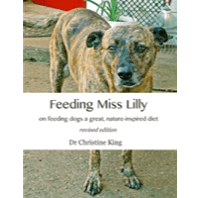Introduction (excerpts)
Imagine if going to the grocery store to shop for yourself and your family is just a matter of going to the human-food aisle and selecting from the range of different flavors of dry or canned food: beef, chicken, turkey, lamb, fish, etc., and these days the plethora of vegetarian and vegan options.
(Come to think of it, I've stood behind people in the checkout line whose shopping carts were piled high with boxes and bags and cans of processed human-food, with no fresh food in their carts at all...)
Even if such foods were "nutritionally complete and balanced," as is the absurd claim on most dry and canned pet-foods, what are the chances that you'd stay healthy for life on such a diet, processed to have a shelf life of months or years, and never eating any fresh foods whatsoever? Certainly, one can survive on such a diet; astronauts do. But thrive? No.
Then, what on earth makes us think our dogs and cats can?
The simple truth is that most can't. I say "most" because you will come across animals who, despite such an unwholesome diet, seem to do OK. But in my experience, these individuals represent a triumph of good genes over bad diet (the George Burns effect, but with food instead of cigars*). Or, as is most often the case, they just haven't lived long enough yet.
For the most part, it's young dogs who still look good on these artificial diets. And when you take a closer look, these dogs are not without diet-related problems after all.
* George Burns was an American comedian who famously smoked cigars, a habit he began when he was 14 years old. It's estimated that he smoked around 300,000 cigars in his lifetime. In his later years, he limited himself to four cigars a day. George Burns lived to be 100 years old, and died quietly at home.
... [skipping to the end of the intro]
beginnings
Miss Lilly arrived as a stray in 2002. Except for her pendulous udder, she was a skin-and-bone life support system for about a million ticks. With her brindle coat and poor condition, she looked like a toast rack. According to her teeth, her behavior with other dogs, and her subsequent development, she was probably 12 to 18 months of age at the time.
I'm as lazy as the next person, so if I could have gotten away with it, I'd probably have fed Miss Lilly some type of dry dog-food for her entire life. I'd already begun my explorations in holistic medicine, but I was still pretty much stuck in the mindset of most dog owners. If asked “what do dogs eat?” I'd have replied “dog-food, of course.” In fact, in vet school we were warned of the many “dangers” of feeding anything but scientifically formulated dog-food, and that included feeding “human food” to dogs. Even today, vet students receive this same lesson — often sponsored by a pet-food company.
Fortunately for my edification, Miss Lilly didn't tolerate either dry or canned dog-food. Not even the "all natural" and "organic" varieties. (And by the way, there's nothing natural or organic about kibble. Where in nature does such a thing exist? What organism made it? Some man in a white lab coat?!)
Miss Lilly brought with her a spectacular array of what I now know to be symptoms of digestive disorder, each one more colorful or odoriferous than the last: frequent vomiting, diarrhea, gurgly belly, foul-smelling gas from both ends, bad breath, mucky teeth and gums, itchy skin, chronic ear infections, low energy, restlessness, and a "dog smell." (I've since learned that truly healthy dogs don't smell "doggy" — except perhaps to cat people.)
No matter which of the dry or canned dog-foods I tried, her symptoms persisted. On the advice of some colleagues, I switched her to a grain-free, raw dog-food, and the light finally came on: her symptoms improved dramatically within the first day or two, and they were all resolved by the time we finished that first batch (about 10 days).
(By the way, not knowing any better, I made that transition from kibble to raw food abruptly: all kibble one meal, all raw the next. As I'll discuss in Chapter 4, that's not always the best thing to do. It worked out OK for us, but I attribute that piece of good luck solely to her youth.)
But, lazy bum that I am at times, and needing to stick to a tight budget, after a few weeks I switched her back to dry food. It was cheaper and I could get it at the grocery store when I did my own shopping. However, all of her symptoms returned — some of them with the first or second meal back on kibble. I was convinced! I promptly switched her back to the grain-free raw food and didn't feed kibble as her basic diet ever again.
(Interestingly, she came to tolerate small amounts of kibble as her health improved. She especially enjoyed it when stolen from someone else's bowl. On her fresh-food, low/no-starch diet, her digestive system, and her body as a whole, became more robust and thus more tolerant — something I'll discuss later in the book.)
biting the bullet
When we moved across the country 3 years later and I couldn't find that particular raw food locally, I tried some other commercially made raw dog-foods, but with far less success. Some of them Miss Lilly didn't care for and refused to eat (they smelled weird to me, too). With others, her symptoms returned or she developed new problems, such as vomiting in the pre-dawn hours because the fat content of the food was too high for her.
I finally bit the bullet and started making her food myself — with much of the trepidation I often see in my clients when I recommend that they do the same.
And so began my adventures in home-making food for my dog. In the following chapters, I'll share what I've learned along the way, feeding Miss Lilly and monitoring the transition to home-made diets in my canine patients.
I've made many mistakes along the way, including accidentally poisoning Miss Lilly with garlic and nearly killing her with some contaminated chicken. Bless her, she kept on going despite my ineptitude, and she forgave most of my mistakes (although she continued to avoid anything with garlic in it).
Lessons learned
What I've learned along the way can be summed up as this: Miss Lilly did best on a home-made diet of fresh meat & veg, mostly raw but some lightly cooked (particularly the veggies), with lots of variety.
Here are the essential elements, and the book in a nutshell:
1. Dogs are carnivores — but while they are true meat-eaters, they are carnivores of the somewhat more casual ('facultative') variety, so dogs do well with some plant material (veggies, seeds, nuts) in their diets. Miss Lilly's diet had a meat-to-veg ratio of around 60:40 (i.e., animals comprised about 60% of her total diet, and plants the rest). But her diet was grain-free and low/no starch, for reasons I'll discuss in Chapter 1. (I'll also explain the term 'facultative' carnivore in that chapter.)
2. Carnivores eat the entire animal — they eat most, if not all, of their prey, and dogs are no exception. So, the more body parts we can get into their diets, the better. Along the same lines, bones are an excellent source of calcium for dogs. (Yes, bones... don't worry, there's a whole section on feeding bones safely in Chapter 2.)
3. The more variety, the better — facultative carnivores eat a wide variety of foods, and again dogs are no exception. The more variety we get into the dog's diet, the less we'll need to supplement, and the fewer problems the dog will have with any one food. I fed Miss Lilly as many different beasts, body parts, and products (e.g., eggs, milk, yoghurt, cheese) as I could manage, as well as lots of different veggies, seeds, nuts, and even the occasional piece of fruit. That's Chapter 3.
4. Carnivores eat their prey raw — and not always fresh. Dogs are well adapted to eating raw meat, even when it has a high bacterial load (although there are limits). I fed most of Miss Lilly's meat raw, although I was careful about handling and storing raw meat. But I fed most of her veggies lightly cooked in order to improve their digestibility and thus their nutrient availability for this carnivorous diner. These are the topics I explore in Chapter 4.
5. Carnivores are meal-feeders — dogs have a fairly large stomach for their body size, so they are adapted to eating one or two meals per day. I fed Miss Lilly (who weighed about 50 pounds or 23 kilograms) roughly 3 to 4 cups of this fresh-food diet each day, divided between a smaller breakfast and a larger dinner. Chapter 5 completes the main part of the book by answering this common question: how much of this food should I feed my dog?
I hope you find this book helpful, and by the end of it you feel well prepared and excited about making your own dog's food, even if you don't cook for yourself. (Although I also hope it inspires you to eat well yourself… ☺︎)


Feeding Miss Lilly
on feeding dogs a great, nature-inspired diet
revised edition
Dr Christine King
PRINT EDITION
USD: 23.96 | AUD: $32.92
eBOOK EDITION
USD: $12.10 | AUD: $17.10